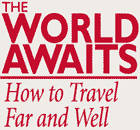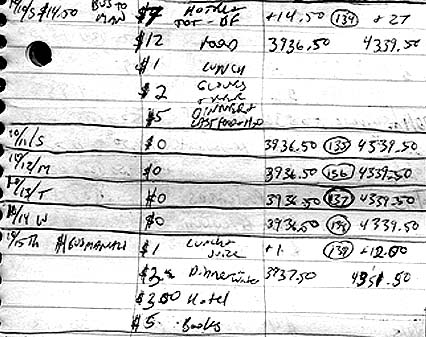11—The Budget
An Overview
Enabler and achilles heel, your travel purse matters. Budgeting wisely can make all the difference. If you're over-ambitious, you can end up starved of the experiences you were seeking, and even in significant trouble.
But who wants to deal with some spreadsheet scheme that requires agonizing pre-planning and excruciating record keeping? No one.
This page draws from the book's examination of budgeting and offers a good way to manage it well, with little hassle.
The first step is to see how your resources (money) match your projected expenses. After gauging your available cash, credit and anticipated income, deal with the costs:
"I recommend the following approach. Start by dividing your costs into categories—perhaps these will serve:
Home Costs
Advance—You’ll be buying some of the following before you leave, and they aren’t cheap: pack, clothing, books and maps, film, shots, visas, camping gear . . . (I’d plan to spend $300–$1,000).
While You’re Gone—This category includes everything that someone will need to pay for you at home while you’re away: rent, utilities, loan payments, insurance premiums, P.O. box fees, alimony, hush money, etc. ($?—This one is all yours.)
Return—When you get home, you may need to afford some things before your income situation shapes up: deposit and first month on an apartment, car registration, job-hunting clothes for your thinner body... ($500–$1,500 might be a fair range).
Travel Costs
Transportation—Includes everything from air packages to taxi fares, whether purchased at home or abroad. ... . $750–$1,500 is a rough range for a medium distance round-trip with a month of “getting around.” $2,000–$3,500 should get you around the world in the Eurasian corridor with moderate surface transit for two to four months. You’ll get more transit over more time for $4,000-$6,000 and/or you’ll be able to add Africa and the South Seas to a round-the-world journey...
Per Diem (daily allowance)—For me, this primarily means food, shelter, admissions, and beer. ... A budget per diem might be $10–$30 ($300–$1,000 per month) in the developing world, $25–$60 ($750–$2,000 per month) in developed nations."
Paul Otteson / The World Awaits / All Rights Reserved
You can pay more or less -- sometimes significantly less -- than I've outlined above, but I'm not strictly a bare bones traveler. I like a couple pints of ale now and then, or some slow coffees at a nice cafe. Beds without lumps and bugs are nice. I also enjoy the freedom, security, and ease of mind that a healthier budget and/or less expensive plan allows.
In the book, I take a detailed look at the difficult task of working out believable home, transportation and travel expenses budgets. It's pretty common sensical as you might expect. One thing I'll emphasize here is the importance of having a good method to keep track of your costs as you go along -- a simple method. It's particularly important on a long trip when your resources aren't going to grow.
"Let’s say you have $3,300—after home and transportation costs have been deducted—for a 120-day African wander. Simple math gives you a per diem allotment of $27.50. Give yourself a cushion by calling it $25. So you can spend 25 smackers a day (fair for many nations, a little low for others). Per diem planning is just that easy. Per diem living, however, requires more care. Keeping the idea that simple is beautiful in mind, here’s how to do it:
1. Keep a roughly accurate record of what you spend as you go along.
2. Periodically compare the plan to reality and adjust.
In order to stay on a budget, you have to know what you’re spending. The best way to do that is to write things down. When you get to a country, memorize a simple exchange rate formula, such as: 15 Malawian Kwachas = 1 U.S. dollar. Then, when you’ve done some spending, mentally translate it into dollars and make a note in your daily record. Something like this, perhaps:
DAY 9
BREAKFAST - $1
LUNCH - $1
DINNER - $3
BEER - $11
REST HOUSE - $3
MISC. - $3
TOTAL - $22
RUNNING TOTAL: $194/$225
So you spent $22 on day 9 of your trip. The total of $194 over nine days compares to the total average allotment of $225. Nice! You’re $31 under budget. Note that by generally rounding up to the nearest dollar, you create a small budget cushion. . . . Note also that by staying out of bars, you can save a small fortune."
Paul Otteson / The World Awaits / All Rights Reserved
I tend to keep my spending record in the back of my journal, which is usually a medium sized spiral notebook. Below is a sample of what your record keeping might actually look like. These six days were in north India -- my last day in Leh, an overnight bus ride and 4-day trek, and my first day in Manali.
Transport is the left column, showing that the bus to the beginning trek point was $14.50, while the bus I hopped for the ride over Rhotang Pass into Manali was only $1. The middle column shows daily expenses, including a guest house + breakfast bill, trek food, lunch, a gloves and kerchief buy, dinner, and a last food and water buy. Four days later, it was lunch and juice on the road, dinner and bottled water in Manali, a hotel room, and books. The right column shows the transport running total on the left, the days out in the middle, and the running total of other expenses on the right:
Simple math shows that, up to this point, the trip was averaging a $31 expenses per diem and a $28 transport per diem. I had already spent time in Europe, Egypt, Turkey, and elsewhere in India.
As you can see, this isn't exactly like the method I describe above, but it's close enough. With very little writing every day or so, I have a useful set of information. Without some sort of record, I wouldn't have known that I was $8200 into my travel purse, or how I should predict the coming months.
Your record-keeping may look different than mine. Your per diem will vary. But the essential principles for managing a budget are the same for both of us:
"1. Know what you can afford.
2. Know what you’re spending.
3. Keep your management strategy as simple as possible."
Paul Otteson / The World Awaits / All Rights Reserved
Credit, Savings, and the Flow of Interest Dollars
How will you store and access your money as you travel? It's an expensive pain to buy a fat wad of travelers checks that you have to wait in countless lines to exchange.
One of the easiest methods is to use credit cards to get cash on the road, and have someone pay your card bills from a savings/checking account back home. Ah! But there are secrets of managing that process that enable you to keep your money earning interest while the credit card interest stays near zero. For now, you'll have to get the details from the book.
Obsession and Peace of Mind
People worry about money -- about having enough, about losing or wasting it, about getting ripped off. Here are some excerpts of a process I describe in the book that enables you to relax about it all:
- "Know exactly how much cash and credit you have available between the times of income that bracket your trip...
- Ruthlessly figure your home costs. Will some money have to go towards storing furniture, feeding a pet, buying a tent, making student loan payments....
- It’s done—$X is it. By simple subtraction, you have determined how much of that dollar figure remains for the actual traveling....
- Cut 10% and call it a margin. ... This number is the wall. Financially plan your trip and replan it again and again until you’re no longer trying to go over, under, or through the wall. ... And how do you know it’s real? You know because any doubts that surface refuse to stick—an intuitive confidence grows and will not be dislodged.
- Remember that, no matter what happens, it will work out somehow. ...
Confidence is the only real path through the minefield of monetary concern. The only way to get it is to earn it or to be a bit of a fool. Personally, I depend on the presence of a small “fool factor” to account for my inability to completely follow my own rules. As long as I get close and build in margins here and there to absorb my mistakes, I travel anxiety free. You can too. No obsessing. It’s nice."
Paul Otteson / The World Awaits / All Rights Reserved
Return to Chapter 10
Continue to Chapter 12
Return to Road Reality


